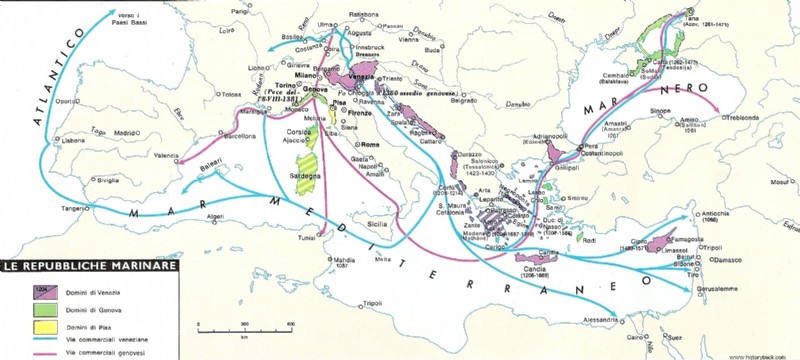Around the year 1000, some coastal cities came to self-govern and formed the so-called republics among which Amalfi emerged , Venice , Pisa and Genoa .
The maritime republics Their activity was mainly commercial but they also constituted an opportunity for cultural contact between Europe and the Arabs.
The exchange led, for example, to the knowledge and dissemination of Arabic numerals.
The first maritime city to organize itself was Amalfi , on the Campania coast, which defeated the Saracens by asserting its commercial autonomy and stipulated economic treaties with the Arabs in Africa and Sicily and with the Byzantines in Spain .
The first nautical charts were made by the Amalfi sailors and the compass was perfected.
The Amalfi Tables they constituted the first maritime code, used by many states with a maritime vocation. The luck and prosperity of Amalfi they ended with the conquest by the Normans, in 1079 .
The Republic of Venice it originated around the 6th century when the citizens took refuge in the internal islets to resist the Lombard invasions. The production of salt was important, which was used to tan the skins, to preserve food and feed livestock.
Around the eighth century Venice conquered hegemony in the Mediterranean trade in goods from the East and was considered "the richest city in gold in the West".
The most prestigious position in the Venetian community was that of Doge , which made use of the contribution of the Maggior Consiglio , elected by the citizens, and the Council of Ten , which had executive functions.
The representatives of these institutions were generally elected from among the representatives of the merchant social class. The cities of Pisa and Genoa were also formed following the need to defend themselves from Saracen attacks in the Tyrrhenian Sea .
Their trading activity expanded mainly in the direction of Africa where in exchange for goods they exported Italian products, including timber and iron.
Between Pisa and Genoa a very heated rivalry soon developed which resulted in the battle of Meloria in 1284 , which saw the victory of Genoa and the end of the Pisan power subsequently incorporated by the hegemony of Florence .

